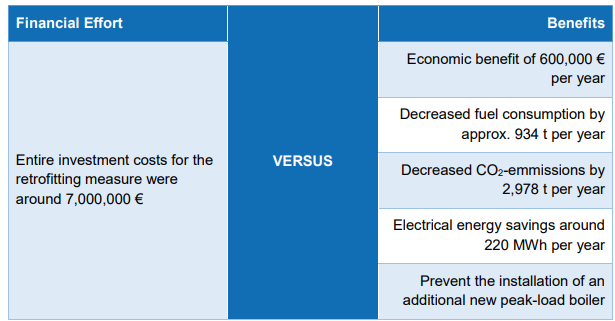Croatia
2015
- Type : Project
- Size : Local community
- Area : Residential
Environmental benefit
Integration of Thermal Storage in Existing DH System in the City of Zagreb
Share
Croatia
2015
- Type : Project
- Size : Local community
- Area : Residential
Environmental benefit
Discover this use case online

In order to increase the efficiency and to lower the costs of the DH system in Zagreb, a buffer
storage tank has been installed at the end of 2015. This project presents the first storage tank
of such size in Croatia and it already provides significant benefits for the DH utility.
With the integrated storage, it was possible to reduce the operating time and fuel consumption
of peak-load boilers, and at the same time to increase the operating time of the cogeneration
plants. This decreased the annual CO2-emmissions. In addition, due to the installation of the
storage system, further invest costs for a new peak-load boiler were avoided.
The project’s motivation was, to achieve multiple benefits with a clear effort in form of invest
costs. The implemented measure was intended to prevent the installation of an additional
peak-load boiler. Most other benefits were caused by the provided flexibility in heat production.
Storages enable to flatten peak-loads (an ideal and quantitative load-profile is illustrated with
the graph below) and in the case of cogeneration plants to give flexibility between the
production of heat and electricity.
Technical Data of the Installed Heat Storage
• The installed heat storage is classified as a daily, cylindrical thermal storage and nonpressurized water tank.
• Storage volume: 21,500 m3
• Heat storage capacity: 750 MWh
• Minimum charging temperature 98 °C
• Maximum returning water temperature: 58 °C
• Loading capacity: 150 MW
The results of the buffer tank implementation in TE-TO Zagreb showed a number of benefits
for the system from both, the technical and the economic side. This project represents a good
role model for other large district heating systems in Croatia. Finally, new district heating
systems in Croatia already replicated this concept, for example in the small renewable district
heating system of Pokupsko.
More info
 R-ACES has received funding from the European Union’s Horizon 2020 research and innovation programme under grant agreement N° 892429
R-ACES has received funding from the European Union’s Horizon 2020 research and innovation programme under grant agreement N° 892429
In order to increase the efficiency and to lower the costs of the DH system in Zagreb, a buffer
storage tank has been installed at the end of 2015. This project presents the first storage tank
of such size in Croatia and it already provides significant benefits for the DH utility.
With the integrated storage, it was possible to reduce the operating time and fuel consumption
of peak-load boilers, and at the same time to increase the operating time of the cogeneration
plants. This decreased the annual CO2-emmissions. In addition, due to the installation of the
storage system, further invest costs for a new peak-load boiler were avoided.
The project’s motivation was, to achieve multiple benefits with a clear effort in form of invest
costs. The implemented measure was intended to prevent the installation of an additional
peak-load boiler. Most other benefits were caused by the provided flexibility in heat production.
Storages enable to flatten peak-loads (an ideal and quantitative load-profile is illustrated with
the graph below) and in the case of cogeneration plants to give flexibility between the
production of heat and electricity.
Technical Data of the Installed Heat Storage
• The installed heat storage is classified as a daily, cylindrical thermal storage and nonpressurized water tank.
• Storage volume: 21,500 m3
• Heat storage capacity: 750 MWh
• Minimum charging temperature 98 °C
• Maximum returning water temperature: 58 °C
• Loading capacity: 150 MW
The results of the buffer tank implementation in TE-TO Zagreb showed a number of benefits
for the system from both, the technical and the economic side. This project represents a good
role model for other large district heating systems in Croatia. Finally, new district heating
systems in Croatia already replicated this concept, for example in the small renewable district
heating system of Pokupsko.
